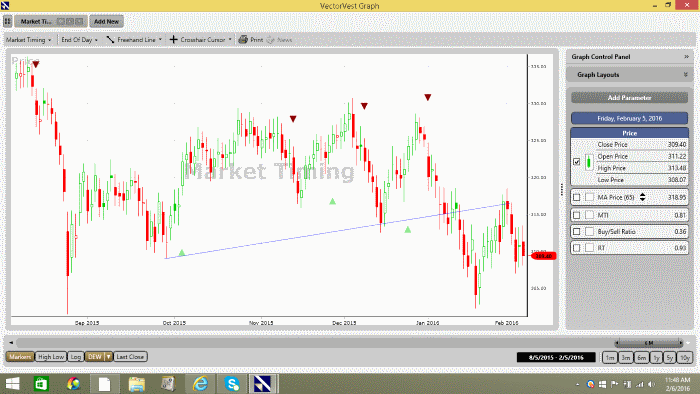As I write after the close on Friday 5th February both the short term trend (Primary Wave) and the underlying trend of the VectorVest Composite UK are down. The NFP number has come and gone and missed analyst’s estimates by quite a large amount. I have no doubt this will be blamed on the weather.
The tone of the FED has become much more dovish in the last few weeks and the futures markets suggest that the increases in rates, communicated towards the end of 2015 are now a pipedream. I have long held to the view that the selloff which proceeded apace from the start of 2016 was all about the cost of money. If rates don’t rise then I feel the probability of a strong rally in an election year grows higher.
As I have said above, there is no sign of this at the moment. For the present the trends are down and stops should be watched in long positions very carefully. We have a full year ahead to make some money, so focus on preserving capital at all costs. Success in the trading business is all about doing the right thing when losing and it’s difficult I know. As Mike Tyson says “Everyone has a plan until they get smacked in the mouth”. Losses can cause the bravest to freeze and do nothing. The VectorVest DEW Market Timing signals on the UK market are shown below.

Last week I mentioned a technique that was my very first trading strategy when I started in 1982. My mentor (that I describe in detail in the VectorVest seminars) loved a selloff. In those days we hand charted and if I didn’t know the names of the shares that were outperforming in the selloff he would shout “everybody wants money but they don’t want to do the work” at the top of his voice. Those shares that perform better than the index in the selloff tend to outperform when the market turns. Those shares that break a new high well before the index gets close to its old high, tend to move strongly.
Using VectorVest all of the hard work is done for you. In addition VectorVest adds the fundamentals into the picture which is something that I didn’t really look at in those early years. It’s no surprise that most of the shares that outperform the index are high VST (Value, Safety and Trend) shares. We still need to be careful, as on occasion a share can be highly rated on VST, solely because of the fundamentals of Value and Safety. VectorVest is not a black box and needs your skill and input. One of the secret of good trading is to find a system or method that suits you. Shares with good fundamentals that break upwards in advance of the Composite after a turn in the Composite are safe bets.
>> Try VectorVest – click here
The Dart Group is a great example of this technique in action. The share has great fundamentals as measured by Value, safety of earnings and earnings potential. In the selloff last August the share came back only slightly and kissed its last high. When the index bottomed out and turned upwards the share broke its high and never looked back. As we all know the index still hasn’t got anywhere near the highs before the August selloff. Dart, after a strong move in 2016, where the index has been hammered, is now charting a “bull flag”. When we get a BUY signal from the index I feel this share will gallop north. Wait for a signal from the market and wait for Dart to break the last high. The technique is great but the greatest trading technique of all is patience and discipline
Bellway shows a similar pattern. In the correction (bear market?) since April last year, Bellway has increased from 20 to 28 pounds. As soon as even the Primary Wave on the Composite turns up, Bellway immediately follows. Recently the Primary wave gave a BUY on the 22nd January. Bellway is clearly in my list of shares with great fundamentals that have outperformed in a market correction. On the 21st Bellway confirms a turn with a hammer candle and moves strongly. If my guess is correct about the FED backing down on rates and this causes a strong move up in markets, then Bellway will be at the front of the pack.
In the selloff over the past few months Fevertree has outperformed. Just a simple eyeball shows this. Again when the Primary Wave turned on the 22nd this share moved strongly northward. Once again the move was confirmed by a hammer candle pattern.
Some rules to ponder over and change to those that suit your trading personality and style.
- Select a Market Timing system such as the Primary Wave for short term traders or the DEW for position traders.
- Compile a list of those shares that have outperformed the market in the last sell off that have good fundamentals. These are mostly high VST shares.
- Wait for a signal to BUY from the market timing signals you close
- When the DEW signal gives a BUY signal, accumulate those shares that break their old highs prior to the index. It’s that simple.
- Short term traders using the Primary wave can consider getting onboard prior to the breakout with a candle pattern. The hammer and outside day being my favorite. All short term traders and spread betters should have a good knowledge of these micro patterns.
- Don’t forget money management and NEVER risk more than 1% of your capital in any single trade.
Again the above is simple and fairly straightforward. It’s also kept me on the winning side for over 30 years.
Try VectorVest for 5 weeks (2 databases)
Please let me know your thoughts
David Paul
February 5th 2016

Be the first to comment on "No Sign of life on the LSE"